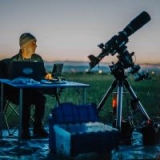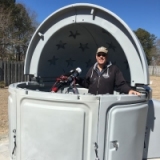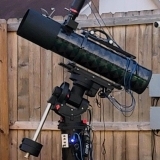INDI Library v2.0.7 is Released (01 Apr 2024)
Bi-monthly release with minor bug fixes and improvements
For those with focus issues
Replied by Giles on topic For those with focus issues
If it is any consolation, the JWST team have the same task, but they're collimating 16 secondary mirrors against a single primary.
Please Log in or Create an account to join the conversation.
- Hy Murveit
-
 Topic Author
Topic Author
- Offline
- Administrator
-

- Posts: 1221
- Thank you received: 565
Replied by Hy Murveit on topic For those with focus issues
Yes, the 2nd pass begins, just like the first, with the focuser moving out and then back in to try to remove backlash. You should be able to see the focuser movements in the logs, or in the log box at the bottom of the Focuser Tab.
There is quite a bit of noise in the HFR calculations for reasons I don't full understand. Perhaps it's seeing, perhaps it's image noise affecting the star extraction scheme, etc. I had hoped my scheme to use the same stars to compare images would remove all that, but when I was testing that change, as I recall, I found some improvement, but I believe the majority of the "HFR noise" remained.
More detail on the first point. I just ran Linear autofocus using the simulator profile, and below are the lines in that log box at the bottom of the Focus Tab. I've highlighted in red lines at the start of the first and 2nd passes that show the focuser moving out then back in.
Hy
2022-01-23T13:01:29 Focus procedure completed after 19 iterations.
2022-01-23T13:01:29 Detection complete.
2022-01-23T13:01:29 Detecting sources...
2022-01-23T13:01:29 Image received.
2022-01-23T13:01:27 Capturing image...
2022-01-23T13:01:24 Detection complete.
2022-01-23T13:01:24 Detecting sources...
2022-01-23T13:01:24 Image received.
2022-01-23T13:01:22 Capturing image...
2022-01-23T13:01:19 Focusing inward by 500 steps...
2022-01-23T13:01:19 Detection complete.
2022-01-23T13:01:19 Detecting sources...
2022-01-23T13:01:19 Image received.
2022-01-23T13:01:17 Capturing image...
2022-01-23T13:01:14 Focusing inward by 1,000 steps...
2022-01-23T13:01:14 Detection complete.
2022-01-23T13:01:14 Detecting sources...
2022-01-23T13:01:14 Image received.
2022-01-23T13:01:12 Capturing image...
2022-01-23T13:01:08 Focusing inward by 1,000 steps...
2022-01-23T13:01:08 Detection complete.
2022-01-23T13:01:08 Detecting sources...
2022-01-23T13:01:08 Image received.
2022-01-23T13:01:06 Capturing image...
2022-01-23T13:01:03 Focusing inward by 1,000 steps...
2022-01-23T13:01:03 Detection complete.
2022-01-23T13:01:03 Detecting sources...
2022-01-23T13:01:03 Image received.
2022-01-23T13:01:01 Capturing image...
2022-01-23T13:00:58 Focusing inward by 1,000 steps...
2022-01-23T13:00:58 Detection complete.
2022-01-23T13:00:58 Detecting sources...
2022-01-23T13:00:58 Image received.
2022-01-23T13:00:56 Capturing image...
2022-01-23T13:00:52 Focusing inward by 10,000 steps...
2022-01-23T13:00:49 Focusing outward by 20,923 steps...
2022-01-23T13:00:49 Detection complete.
2022-01-23T13:00:49 Detecting sources...
2022-01-23T13:00:49 Image received.
2022-01-23T13:00:47 Capturing image...
2022-01-23T13:00:44 Focusing inward by 2,000 steps...
2022-01-23T13:00:44 Detection complete.
2022-01-23T13:00:44 Detecting sources...
2022-01-23T13:00:44 Image received.
2022-01-23T13:00:42 Capturing image...
2022-01-23T13:00:38 Focusing inward by 2,000 steps...
2022-01-23T13:00:38 Detection complete.
2022-01-23T13:00:38 Detecting sources...
2022-01-23T13:00:38 Image received.
2022-01-23T13:00:36 Capturing image...
2022-01-23T13:00:33 Focusing inward by 2,000 steps...
2022-01-23T13:00:33 Detection complete.
2022-01-23T13:00:33 Detecting sources...
2022-01-23T13:00:33 Image received.
2022-01-23T13:00:31 Capturing image...
2022-01-23T13:00:27 Focusing inward by 2,000 steps...
2022-01-23T13:00:27 Detection complete.
2022-01-23T13:00:27 Detecting sources...
2022-01-23T13:00:27 Image received.
2022-01-23T13:00:25 Capturing image...
2022-01-23T13:00:22 Focusing inward by 2,000 steps...
2022-01-23T13:00:22 Detection complete.
2022-01-23T13:00:22 Detecting sources...
2022-01-23T13:00:22 Image received.
2022-01-23T13:00:20 Capturing image...
2022-01-23T13:00:16 Focusing inward by 2,000 steps...
2022-01-23T13:00:16 Detection complete.
2022-01-23T13:00:16 Detecting sources...
2022-01-23T13:00:16 Image received.
2022-01-23T13:00:14 Capturing image...
2022-01-23T13:00:11 Focusing inward by 2,000 steps...
2022-01-23T13:00:11 Detection complete.
2022-01-23T13:00:11 Detecting sources...
2022-01-23T13:00:11 Image received.
2022-01-23T13:00:09 Capturing image...
2022-01-23T13:00:05 Focusing inward by 2,000 steps...
2022-01-23T13:00:05 Detection complete.
2022-01-23T13:00:05 Detecting sources...
2022-01-23T13:00:05 Image received.
2022-01-23T13:00:03 Capturing image...
2022-01-23T13:00:00 Focusing inward by 2,000 steps...
2022-01-23T13:00:00 Detection complete.
2022-01-23T13:00:00 Detecting sources...
2022-01-23T13:00:00 Image received.
2022-01-23T12:59:58 Capturing image...
2022-01-23T12:59:54 Focusing inward by 2,000 steps...
2022-01-23T12:59:54 Detection complete.
2022-01-23T12:59:54 Detecting sources...
2022-01-23T12:59:54 Image received.
2022-01-23T12:59:52 Capturing image...
2022-01-23T12:59:49 Focusing inward by 2,000 steps...
2022-01-23T12:59:49 Detection complete.
2022-01-23T12:59:49 Detecting sources...
2022-01-23T12:59:49 Image received.
2022-01-23T12:59:47 Capturing image...
2022-01-23T12:59:42 Focusing inward by 10,000 steps...
2022-01-23T12:59:41 Focusing outward by 12,000 steps...
Please Log in or Create an account to join the conversation.
- Ron Clanton
-

- Offline
- Elite Member
-

- Posts: 225
- Thank you received: 16
Replied by Ron Clanton on topic For those with focus issues
I was referring to the your description of "Once it passes the min position..." If it doesn't find a better solution, how does it get back to the min position? Hopefully by moving back an exaggerated amount and then moving back to it (thus eliminating backlash)?
I know I'm reaching...
Thanks,
Ron
Please Log in or Create an account to join the conversation.
- Ron Clanton
-

- Offline
- Elite Member
-

- Posts: 225
- Thank you received: 16
Replied by Ron Clanton on topic For those with focus issues
LOL! Perhaps!
I'm not convinced that it's the cause of my focusing issues... but I'm also checking it tonight.
Ron
Please Log in or Create an account to join the conversation.
- Hy Murveit
-
 Topic Author
Topic Author
- Offline
- Administrator
-

- Posts: 1221
- Thank you received: 565
Replied by Hy Murveit on topic For those with focus issues
Please Log in or Create an account to join the conversation.
- Ron Clanton
-

- Offline
- Elite Member
-

- Posts: 225
- Thank you received: 16
Replied by Ron Clanton on topic For those with focus issues
Forgive me... I'm not sure that I understand the process. In my words:
First pass: Moves out an exaggerated amount, moves in to the multiple of initial step. (My case 5 x 20 steps) It identifies minimum HFR spot.
Second pass: Moves out an exaggerated amount, move in to the multiple of 1/2 step (5x10) from minimum HFR spot. It measures each stop's HFR until it reaches the first pass minimum, then continues past this spot at 1/4 step. Per your comment: "In this 2nd pass it is using step_size/2, and once it passes the 1st pass' min position it uses step_size/4".
So if it fails to find a better HFR once it passes the 1st pass' min position... how does it return to that spot?
Does my question make sense?
Thanks,
Ron
Please Log in or Create an account to join the conversation.
- Hy Murveit
-
 Topic Author
Topic Author
- Offline
- Administrator
-

- Posts: 1221
- Thank you received: 565
Replied by Hy Murveit on topic For those with focus issues
First pass: more or less like you said. Identifies a best position and best HFR.
2nd pass: Moves in at "1/2 step size" increments looking for a measurement within "tolerance" of "1st pass' best HFR". If it never finds one it will repeat the 2nd pass, until it runs out of iterations (I think it fails after 30 images). When it finds something within the tolerance, is says "Solution pending" and in a greedy fashion continues sampling at the same "1/2 step-size" increments until the measurements stop improving. Once they stop improving, it ends with no further movement. (As a detail, it resamples the same position a few times when the HFR stops improving in case the lack of improvement was noise in the HFR value.) If it happens to pass the 1st pass' "best position" then it reduces its step size to "1/4 step size".
My assumption in all this is that the focuser cannot move reliably to a certain position, or know how the position number now compares to some position number from the first pass. If it could move reliably, it should just run the first pass and then move to that best position with no 2nd pass needed. For that matter, if your focuser can move reliably to a certain position, you should just use the polynomial algorithm and autofocus much faster.
Please Log in or Create an account to join the conversation.
- Ron Clanton
-

- Offline
- Elite Member
-

- Posts: 225
- Thank you received: 16
Replied by Ron Clanton on topic For those with focus issues
Thanks for the explanation!
So ultimately it will settle one move past the best HFR. That explains a lot, as I've wondered why it doesn't settle on the best HFR on the first pass. I agree that is "good enough" as it is within the set tolerance. On my other refractor, the focuser is pretty good so I can use the polynomial method pretty reliably. On this SCT... not so much. I'm hoping that I have the patience to deal with all the variables with the SCT.
Unfortunately, our forecast has changed and all I'm seeing is clouds tonight. However, I'll post my results once I get clear skies.
Thanks,
Ron
Please Log in or Create an account to join the conversation.
Replied by Eric on topic Re:For those with focus issues
About out-of-focus situations, would it be helpful if the algorithm was considering a "focus quality" as the ratio of number of stars over HFR and tried to maximise that?
And finally, except for surface focusing where it is obviously much needed, would maximising the frequency range on a Fourier transform of a focus frame be a good quality function for some setups?
-Eric
Please Log in or Create an account to join the conversation.
- Ron Clanton
-

- Offline
- Elite Member
-

- Posts: 225
- Thank you received: 16
Replied by Ron Clanton on topic Re:For those with focus issues
I'll let Hy respond to the more technical aspects of your suggestions. However, I'm not sure that number of stars is a reliable measure of quality. My experience is that it is more a function of seeing as opposed to focus... but just my opinion.
After all of this helpful discussion, I'm thinking that my issues may be solved by adjusting the various settings (step size, star selection, etc.) and improving collimation.
Thanks!
Ron
Please Log in or Create an account to join the conversation.
Replied by Jim on topic For those with focus issues
Please Log in or Create an account to join the conversation.
- Sonny Cavazos
-

- Offline
- Elite Member
-

- Posts: 239
- Thank you received: 38
Replied by Sonny Cavazos on topic For those with focus issues
Plus my Mak-Newts are optimized for APS-C sensors, when I use a larger sensor, I have to cut out the edges so the focus procedure works best.
Please Log in or Create an account to join the conversation.
